Related Research Articles
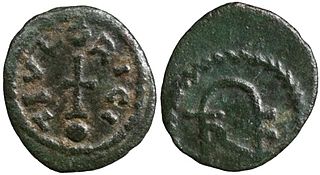
Theuderic I was the Merovingian king of Metz, Rheims, or Austrasia—as it is variously called—from 511 to 534.
Pope Adeodatus I, also called Deodatus I or Deusdedit, was the bishop of Rome from 19 October 615 to his death. He was the first priest to be elected pope since John II in 533. The first use of lead seals or bullae on papal documents is attributed to him. His feast day is 8 November.
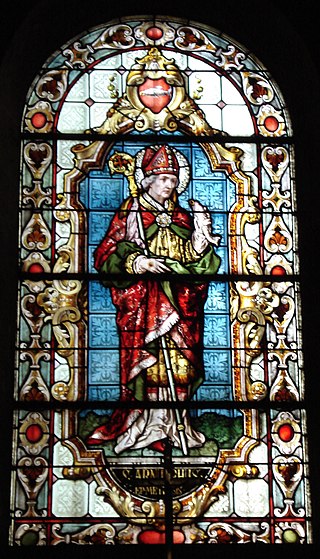
Arnulf of Metz was a Frankish bishop of Metz and advisor to the Merovingian court of Austrasia. He later retired to the Abbey of Remiremont. In French he is also known as Arnoul or Arnoulf. In English he is known as Arnold.
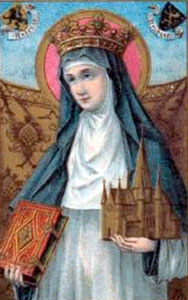
Saint Begga was the daughter of Pepin of Landen, mayor of the palace of Austrasia, and his wife Itta of Metz. She is also the grandmother of Charles Martel, who is the grandfather of Charlemagne.

Saint Dominic,, also known as Dominic de Guzmán, was a Castilian Catholic priest and the founder of the Dominican Order. He is the patron saint of astronomers and natural scientists. He is alternatively called Dominic of Osma, Dominic of Caleruega, and Domingo Félix de Guzmán.

Lorsch Abbey, otherwise the Imperial Abbey of Lorsch, is a former Imperial abbey in Lorsch, Germany, about 10 km (6.2 mi) east of Worms. It was one of the most renowned monasteries of the Carolingian Empire. Even in its ruined state, its remains are among the most important pre-Romanesque–Carolingian style buildings in Germany. Its chronicle, entered in the Lorscher Codex compiled in the 1170s, is a fundamental document for early medieval German history. Another famous document from the monastic library is the Codex Aureus of Lorsch. In 1991 the ruined abbey was listed as a UNESCO World Heritage Site because of its architectural and historical importance.
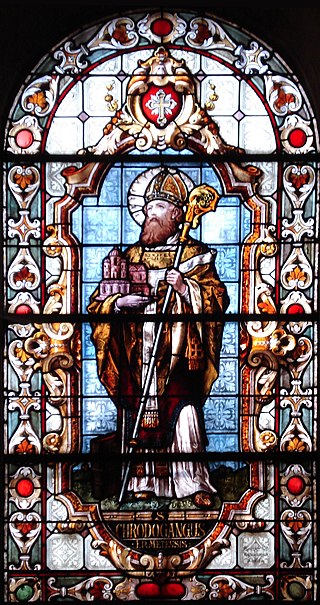
Chrodegang was the Frankish Bishop of Metz from 742 or 748 until his death. He served as chancellor for his kinsman, Charles Martel. Chrodegang is claimed to be a progenitor of the Frankish dynasty of the Robertians. He is recognized as a saint in the Catholic Church
Máel Ruba is an Irish saint of the Christian Church who was active in Scotland. Originally from Bangor, County Down, Ireland, he was a monk and founded the monastic community of Applecross in Ross, one of the best attested early Christian monasteries in what is now Scotland. Forms of his name include Máelrubai, Maol Rubha (MoRubha/MaRuibhe), or Malruibhe, and it is sometimes latinised as Rufus,
Itta of Metz, O.S.B. was the wife of Pepin of Landen, Mayor of the Palace of the Kingdom of Austrasia. After his death, she founded the Abbey of Nivelles, where she became a Colombanian nun along with her daughter, Gertrude of Nivelles. Both are honored as saints by the Catholic Church.

The Diocese of Metz is a Latin Church ecclesiastical territory or diocese of the Catholic Church in France. In the Middle Ages it was a prince-bishopric of the Holy Roman Empire, a de facto independent state ruled by the prince-bishop who had the ex officio title of count. It was annexed to France by King Henry II in 1552; this was recognized by the Holy Roman Empire in the Peace of Westphalia of 1648. It formed part of the province of the Three Bishoprics. Since 1801 the Metz diocese has been a public-law corporation of cult. The diocese is presently exempt directly to the Holy See.
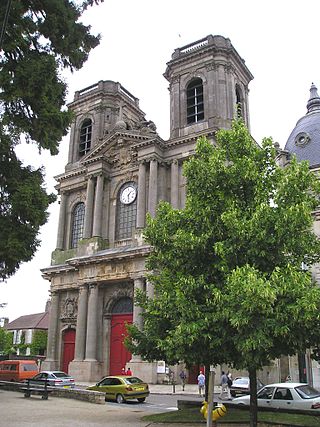
The Roman Catholic Diocese of Langres is a Roman Catholic diocese comprising the département of Haute-Marne in France.
There are several saints named Rufus, of which the Roman Martyrology records ten; historical mention is made of the following ones, which have liturgical feasts:
- On 19 April, a group of martyrs in Melitene in Armenia, one of whom bears the name of Rufus. These martyrs are mentioned already in the Martyrologium Hieronymianum.
- On 1 August, Rufus, with several companions who, according to the most reliable manuscripts of the "Martyrologium Hieronymianum" died at Tomi, the place being afterwards by mistake changed to Philadelphia.
- On 27 August, two martyrs named Rufus at Capua -- one, whose name also appears as Rufinus in the "Martyrologium Hieronymianum". The other is said to have suffered with a companion, Carponius, in Diocletian's persecution circa 304 AD.
- On 25 September, several martyrs at Damascus, among them one named Rufus.
- On 7 November, a Rufus of Metz, who is said to have been Bishop of Metz; his history, however, is legendary. His name was inserted at a later date in an old manuscript of the "Martyrologium Hieronymianum"(ed. cit., 140). In the ninth century his relics were transferred to Gau-Odernheim in Hesse, Diocese of Mainz.
- On 12 November, Rufus, legend, without any historical proof, the supposed first Bishop of Avignon, who is perhaps identical with Rufus, the disciple of Paul. [cf. Louis Duchesne, "Fastes épiscopaux de l'ancienne Gaule", I, 258; Duprat in "Mémoires de l'Académie de Vaucluse" (1889), 373 sqq.; (1890), 1 sqq., 105 sqq.].
- On 21 November, Rufus the disciple of the Apostles, who lived at Rome and to whom Saint Paul sent a greeting, as well as he did also to the mother of Rufus. St. Mark says in his Gospel that Simon of Cyrene was the father of Rufus, and as Mark wrote his Gospel for the Roman Christians, this Rufus is probably the same as the one to whom Paul sent a salutation [cf. Cornely, "Commentar. in Epist. ad Romanos", 778 sq.].
- On 28 November, a Roman martyr Rufus, probably identical with the Rufinianus who was buried in the Catacomb of Generosa on the Via Portuensis, and who is introduced in the legendary Acts of the martyrdom of St. Chrysogonus.
- On 18 December, the holy martyrs Rufus and Zosimus, who were taken to Rome with St. Ignatius of Antioch and were put to death there for their unwavering confession of Christianity during the persecution of Trajan. St. Polycarp speaks of them in his letter to the Philippians.
Saint Trudo was a saint of the seventh century. He is called the "Apostle of Hesbaye". His feast day is celebrated on 23 November.

Winibald was abbot of the Benedictine double monastery of Heidenheim am Hahnenkamm. Traditionally, he is called the brother of Willibald and Walpurga.
Cancor was a Frankish count associated with Lorsch Abbey. He was son of a noble lady Williswinda. As her only known husband before she was widowed was named Robert, it has been proposed that Cancor was son to Robert I, Count of Hesbaye, who was also alive in the 8th century.

Saint Clement of Metz is venerated as the first Bishop of Metz. According to tradition, he was sent by Saint Peter to Metz during the 1st century, with two disciples: Celestius and Felix, who are listed as his successors in that see. However, this legend may have been constructed much later to lend more antiquity to the episcopal see, and to make the diocese of Metz appear to be more ancient than it actually was. As Hippolyte Delehaye writes, "To have lived amongst the Saviour's immediate following was...honorable...and accordingly old patrons of churches were identified with certain persons in the gospels or who were supposed to have had some part of Christ's life on earth." Elaboration of this legend states that Clement was the uncle of Pope Clement I.
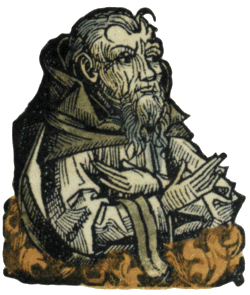
Saint Goar of Aquitaine was a French priest and hermit of the seventh century. He was offered the position of Bishop of Trier, but prayed to be excused from the position. Goar is noted for his piety and is revered as a miracle-worker. He is a patron saint of innkeepers, potters, and vine growers.

Remiremont Abbey was an abbey that was founded as a house of nuns near Remiremont, Vosges, France. It later became a community of secular canonesses.

Papal appointment was a medieval method of selecting a pope. Popes have always been selected by a council of Church fathers, however, Papal selection before 1059 was often characterized by confirmation or nomination by secular European rulers or by their predecessors. The later procedures of the papal conclave are in large part designed to constrain the interference of secular rulers which characterized the first millennium of the Roman Catholic Church, and persisted in practices such as the creation of crown-cardinals and the jus exclusivae. Appointment might have taken several forms, with a variety of roles for the laity and civic leaders, Byzantine and Germanic emperors, and noble Roman families. The role of the election vis-a-vis the general population and the clergy was prone to vary considerably, with a nomination carrying weight that ranged from near total to a mere suggestion or ratification of a prior election.
The Metropolis of Thebes and Livadeia is a metropolitan see of the Church of Greece in Boeotia, Greece. Since the Middle Ages it has also existed as a Roman Catholic titular see. The current metropolitan is Georgios Mantzouranis.
References
- ↑ Latin Saints of the Orthodox Patriarchate of Rome
- ↑ St. Rufus of Metz - Saints & Angels - Catholic Online
- ↑ Kirsch, Johann Peter (1913). . Catholic Encyclopedia . Vol. 13, see para (5).